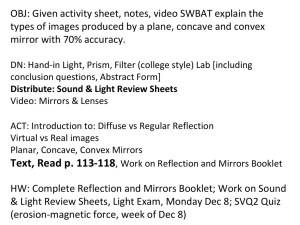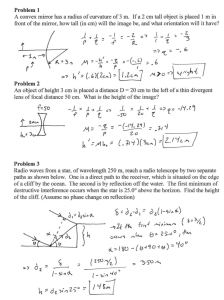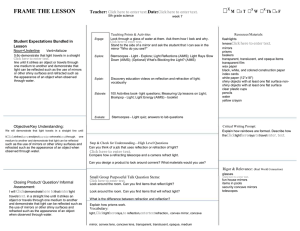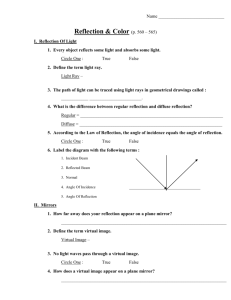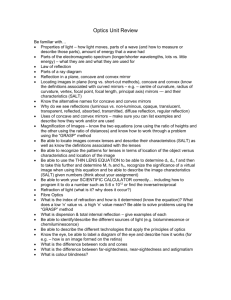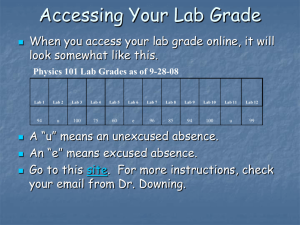Reflection & Mirrors
advertisement
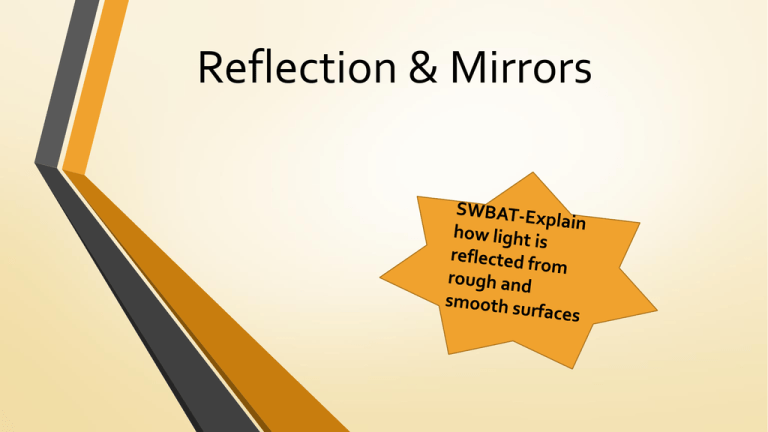
Reflection & Mirrors Science Starter Describe how light travels. The Law of Reflection • Law of Reflection-When a light ray strikes a surface and is reflected • Normal-Imaginary line that is drawn perpendicular to the surface where the light ray strikes. The Law of Reflection • The incident ray and the normal form an angle called the angle of incidence. • The reflected light ray forms an angle with the normal called the angle of reflection. The Law of Reflection • law of reflection states that the angle of incidence is equal to the angle of reflection. Reflection from Surfaces— Regular VS Diffuse Reflection Rough Surface Reflection • uneven reflection of light waves from a rough surface • Causes light waves to reflect in all directions Smooth Surface Reflection • Even/parallel reflection of light waves from and even surface Continue Here on Monday! Concave VS Convex Mirrors Convex Mirror • has a surface that curves outward, like the back of a spoon • Convex mirrors cause light waves to spread out, or diverge. Concave Mirror • a surface that is curved inward, like the bowl of a spoon. • Unlike plane mirrors, concave mirrors cause light rays to come together, or converge Scattering of Light • When diffuse reflection occurs, light waves that were traveling in a single direction are reflected, and then travel in many different directions. • This is known as scattering. • Scattering also can occur when light waves strike small particles, such as dust. Reflection and Mirrors 2 Reflection by Plane Mirrors • Light waves from the Sun or another source of light strike each part of the person. • These light rays bounce off the person according to the law of reflection, and some of them strike the mirror. Reflection and Mirrors 2 Reflection by Plane Mirrors • The rays that strike the mirror also are reflected according to the law of reflection. Reflection and Mirrors 2 The Image in a Plane Mirror • Although the light rays bounced off the mirror’s surface, your brain interprets them as having followed straight lines. • This makes the reflected light rays look as if they are coming from behind the mirror. Reflection and Mirrors 2 Concave Mirrors • A straight line drawn perpendicular to the center of a concave or convex mirror is called the optical axis. • Light rays that travel parallel to the optical axis and strike the mirror are reflected so that they pass through a single point of the optical axis called the focal point. • The distance along the optical axis from the center of the mirror to the focal point is called the focal length. Reflection and Mirrors 2 Concave Mirrors • If the object is farther from the mirror than the focal point, the image appears to be upside down, or inverted. • The size of the image decreases as the object is moved farther away from the mirror. • If the object is closer to the mirror than one focal length, the image is upright and gets smaller as the object moves closer to the mirror. Reflection and Mirrors 2 Concave Mirrors • A concave mirror can produce a focused beam of light if a source of light is placed at the mirror’s focal point. • Flashlights and automobile headlights use concave mirrors to produce directed beams of light. Reflection and Mirrors 2 Convex Mirrors • A convex mirror causes light rays to spread apart, or diverge. Reflection and Mirrors 2 Convex Mirrors • Like the image formed by a plane mirror, the image formed by a convex mirror seems to be behind the mirror. The image always is upright and smaller than the object. Section Check 2 Question 1 According to the law of reflection, the _______ is equal to the _______. Section Check 2 Answer The law of reflection states that the angle of incidence is equal to the angle of reflection.

